Top Influential Mathematicians Today
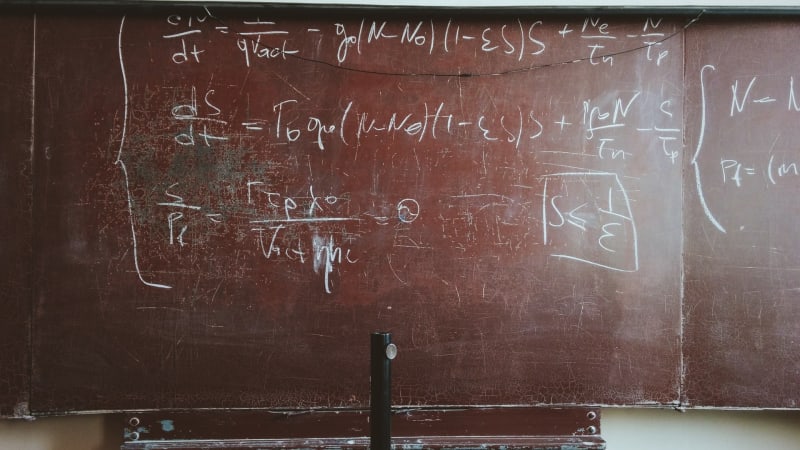
Mathematics is very old. In fact, it dates back to the cradle of civilization, emerging out of the early societies in Ancient Egypt and Sumeria (modern day Iraq). Like our natural languages, the development of mathematics probably started for practical reasons, like keeping track of inventory and taxes. Keeping track means counting (and measuring), and to a large extent, the study of math is still rooted in numbers. But math is so much more.
Considering a degree in mathematics? Visit Our Math Page, where you’ll find the best math colleges and universities, career information, interviews with top mathematicians, influential scholars in the field of mathematics, great books, a history of the discipline, online math degrees, and more.
If you already have a bachelor’s degree in mathematics and are wondering if pursuing an advanced degree in mathematics will help to advance your career, check out what you can do with a master’s degree in mathematics.
Did you know that a degree in mathematics is a future-proof degree that can qualify you for an extremely wide range of jobs in a variety of high-growth industries? This degree can put you in a strong position to take on new roles necessitated by the rise in machine learning and AI-based technology.
Early Greek thinkers extended the Egyptian and Sumerian systems to the mathematics of shapes and places, with Euclid’s geometry. The Scientific Revolution brought us systems for describing rates of change-the calculus, developed by Enlightenment geniuses like Isaac Newton and Gottfried Leibnitz. Today, we have string theory, knot theory, and the abstract analysis of multi-dimensional shapes that would seem bizarre to the ancients (and to non-mathematicians today).
Mathematics has continually expanded into more and more powerful and abstract areas of study. Professional mathematicians understandably specialize, and only a few truly great mathematicians can honestly be said to understand most of the field. Yet, in the end, mathematics remains counting. The study of numbers (and numerical treatments of structures, shapes, and changes) is one of the most powerful fields of study-one of the central discoveries of all of humankind-that has made possible modern science and technology, from abstract physics to the blueprints for an iPhone or automobile. Math runs the world. And in this list, we’ll get introduced to the most influential-and brilliant-mathematicians in our modern world.
In what follows, we look at influential mathematicians over the last decade. Based on our ranking methodology, these individuals have significantly impacted the academic discipline of mathematics within 2010-2020. Influence can be produced in a variety of ways. Some have had revolutionary ideas, some may have climbed by popularity, but all are academicians primarily working in mathematics. Read more about our methodology.
Note: This isn’t simply a list of the most influential mathematicians alive today. Here we are focused on the number of citations and web presence of scholars in the last 10 years. There are other highly influential scholars who simply haven’t been cited and talked about as much in the last 10 years, whereas some new faces have been making a splash in the news, speaking events, and publishing, publishing, publishing. Our AI is time sensitive. To find some of the big names you might have expected to see here, we encourage you to use our dynamic ranking system and check influence over the past 20 and 50 years.
Top Influential Mathematicians
2010-2020
Want more? Discover influential mathematicians throughout history: Of All Time | Last 50 Years | Last 20 Years | Black Mathematicians | Women Mathematicians Note: The time-specific links above take you to rankings that dynamically change as our AI learns new things!
1.Keith Devlin

(1947 - )
Hull, England
Areas of Specialization: Theory of Information, Models of Reasoning, Mathematical Cognition
Devlin is formerly a Consulting Professor of Mathematics at Stanford University and now co-founder and Executive Director of Stanford’s Human-Sciences and Technologies Advanced Research Institute, founded in 2006. He is also a member of Stanford’s Center for the Study of Language and Information (CSLI), an important research center for work in computational linguistics, computer science, and mathematics. Devlin received his bachelor’s (special) in mathematics at Kings College, London and his Ph.D. in Mathematics from the University of Bristol in 1971.
Devlin is a prolific writer about mathematics and related scientific disciplines, writing both for specialists and a general readership. He has authored over 30 books during his storied career as a mathematician, and 80 research articles! No wonder, then, that in 2007 Devlin was awarded the Carl Sagan Prize for Science Popularization. These days, Devlin’s research is focused mainly on applying media and other technologies to help students and others learn about math. For instance, he is co-founder and president of BrainQuake, a company that makes video games to facilitate learning mathematics. He is also known as the “Math Guy” on NPR’s Weekend Edition Saturday, where he is a commentator.
Devlin became a Fellow of the American Mathematical Society in 2012.
2.Terence Tao

(1975 - )
Adelaide, South Australia, Australia
Areas of Specialization: Green-Tao Theorem, Erdős Discrepancy Problem, Compressed Sensing, Tao’s Inequality, Analysis, Oscillatory Integrals
Tao is arguably the greatest living mathematician, and has been called the greatest mathematician of his generation. Born in South Australia, Tao was a child prodigy, the youngest person ever to win a medal in the International Mathematical Olympiad-he was ten. He has since won the Field Medal, the “Nobel Prize” for mathematicians. Terence Tao holds the James and Carol Collins Chair in Mathematics at the University of California, Los Angeles (UCLA).
At the age of 14, Tao attended the Research Science Institute, a summer seminar for talented high school students hosted by the Massachusetts Institute of Technology (MIT). At the age of 16, he received his bachelor’s and master’s degrees in mathematics at Princeton University. He received his Ph.D. from Princeton at age 20. He joined UCLA at the age of 24 and became the youngest person ever appointed to full professor by the university.
Tao’s focus is on partial differential equations, a nonlinear area of calculus, or the mathematics of change. Those who know him are quick to point out that he has an impressive grasp of seemingly all of mathematics-a rare feat, particularly today in an age of specialization. He has also done important work in fields as diverse as probability theory to number theory. As fellow mathematician Timothy Gowers put it when reviewing one of Tao’s books, “it is not easy to find gaps in Tao’s knowledge, and if you do then you may well find that the gaps have been filled a year later.”
Tao has won numerous awards, including but not limited to the Field Medal (referenced above), in 2006 a MacArthur Award (the “genius” award), Fellow of the Royal Society (2007), and in 2009 he was inducted into the American Academy of Arts and Sciences.
3.Ian Stewart

(1945 - )
England
Areas of Specialization: Catastrophe theory, Dynamical Systems, Bifurcation Theory, Pattern Formation, Biomathematics
Stewart is Emeritus Professor of Mathematics at the University of Warwick, England. Stewart received his bachelor’s of arts degree (first class) in mathematics from the University of Cambridge in 1966 and his Ph.D. in Mathematics at the University of Warwick in 1969.
Stewart is a gifted mathematician who is also a writer of popular science and science fiction. A fertile mind, his primary focus in mathematics is a subfield of the study of dynamic systems known as catastrophe theory. He has also published widely on diverse topics in mathematics, including his book on chaos theory, Does God Play Dice: The New Mathematics of Chaos, published in 1989. Over the years, he has written nearly 100 articles for the well-known science and mathematics publication Scientific American. He even has his own iPad app, Incredible Numbers by Professor Ian Stewart.
Stewart received the Michael Faraday Medal in 1995 for “communicating science to UK audiences,” the mission of the Medal. He was elected a Fellow of the Royal Society in 2001.
4.John Stillwell

(1942 - )
Melbourne, Australia
Areas of Specialization: History of Mathematics, Number Theory, Geometry, Foundations of Mathematics
Born in Melbourne, Australia, John Stillwell holds the title of professor emeritus at the University of San Francisco. Though Stillwell came to USF in 2002, he spent the bulk of his career at Monash University in Melbourne from 1970-2001. Stillwell earned his PhD at Massachusetts Institute of Technology in 1970.
Stillwell is best known as a source of knowledge and education in mathematics. He has been influential as the author of numerous books on subjects in mathematics, including the history of math in the last two centuries, the foundations of mathematics, algebra, number theory, and geometry. His books are both widely-used textbooks, and popular publications, such Mathematics and its History, Yearning for the Impossible and Reverse Mathematics.
For his work, Stillwell has received awards and honors including the Chauvenet Prize of the Mathematical Association of America, the book award of the Association of Jesuit Colleges and Universities, and was invited to speak at the International Congress of Mathematicians in 1994.
5.Bruce C. Berndt
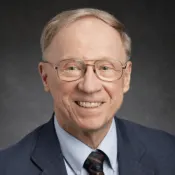
(1939 - )
St. Joseph, Michigan, USA
Areas of Specialization: Analytic Number Theory, Special Functions, q-series, Continued Fractions
Berndt is the Michio Suzuki Distinguished Research Professor of Mathematics at the University of Illinois Urbana-Champaign. Berndt received his undergraduate degree from Albion College in Michigan in 1961. He received his master’s and Ph.D. in Mathematics from the University of Wisconsin–Madison. With the exception of a year as visiting professor at the University of Glasgow in Scotland and a one-year stint at the Institute for Advanced Study at Princeton, Berndt has enjoyed his long and stellar career teaching and researching mathematics at the University of Illinois.
Berndt is world-famous as one of the greatest analytic number theorists, a core area in mathematics exploring the properties of number systems, such as the integers. He is perhaps best known for working out the results of the singular genius Srinivasa Ramanujan, a “prophet” of mathematics discovered by talents in the United States after solving some of the world’s most difficult problems in mathematics without the benefit of formal and extensive mathematical training. Berndt received a coveted Steele Prize for his work on Ramanujan’s notebooks, and also serves as editor of the Ramanujan Journal.
Berndt was named Fellow of the American Mathematical Society in 2012. In 2012, SASTRA University in India also awarded him an honorary doctorate.
6.Timothy Gowers

(1963 - )
Wiltshire, England, UK
Areas of Specialization: Functional analysis, Combinatorics
Gowers is Royal Society Research Professor at the Department of Pure Mathematics and Mathematical Statistics at the University of Cambridge, UK. He also holds the Rouse Ball Chair in Mathematics at Cambridge (Roger Penrose holds this Chair at the other granting institution, Oxford), and is a Fellow of Trinity College, Cambridge. Gowers received his early training at King’s College and Eton, where he was a King’s Scholar. He received his Ph.D. from Trinity College, Cambridge University in 1990.
A British mathematician, Gowers’ work has been primarily in functional analysis, and in particular in the vector construct known as a Banach space. He has also performed fundamental work in combinatorics and number theory (of combinatorial number theory), proving a number of important lemmas and results, as well as introducing the concept of a quasi random group in 2005. Most recently, Gowers has taken up the perennial problem in mathematics, the conjecture that “P does not equal NP,” or in other words that complex problems in computational theory (NP problems) cannot be reduced to a simpler class of problem, known as P.
Gowers also helped to popularize mathematics, writing a book for a general readership in 2002 titled Mathematics: A Very Short Introduction. Interestingly, he also served as a consultant on the movie Proof in 2005. He is also active in encouraging collaboration on difficult problems in mathematics online.
Gowers won the Fields Medal in 1998. He was knighted by the Queen (British Monarchy) for his services to mathematics in 2012.
7.Peter Sarnak

(1953 - )
Johannesburg, South Africa
Areas of Specialization: Hafner-Sarnak-McCurley Constant, Number Theory and Analysis, Combinatorics, Mathematical Physics
Sarnak is a permanent faculty member in Mathematics at the Institute for Advanced Study (IAS). The IAS is located on 1 Einstein Drive in Princeton, New Jersey, an address inspired by Albert Einstein’s famous tenure there in the early and mid-20th century. Some of the greatest mathematical minds in modern times have called the IAS home, like John Von Neumann of early computing fame. Sarnak is thus in good company, past and present. Sarnak is also the Eugene Higgins Professor of Mathematics at Princeton University.
Sarnak received two bachelor’s degrees in mathematics from the University of the Witwatersrand in South Africa in 1975 and 1976 and his Ph.D. in Mathematics from Stanford University in 1980. He works on problems in analytic number theory, and his contributions have had important applications to other scientific areas like physics and computer science. Sarnak also invented a field known as “arithmetical quantum chaos,” and performed work leading to a solution to a famous unsolved problem in mathematics known as Hilbert’s Eleventh Problem after mathematician David Hilbert, a 19th century mathematician who issues a challenge to mathematicians at the turn of the 19th century as a list of twelve unsolved problems.
Sarnak has won numerous awards during his outstanding career in number theory, including the George Polya Prize in 1998, and most recently a Sylvester Medal in 2019.
8.Martin Hairer

(1975 - )
Geneva, Switzerland
Areas of Specialization: Probability Theory, Analysis
Sir Martin Hairer is currently a professor of mathematics and Chair in Probability and Stochastic Analysis at Imperial College London in the Faculty of Natural Sciences, Department of Mathematics. Previously, he held roles at the University of Warwick, and the Courant Institute of New York University. An Austrian Citizen born in Geneva, Switzerland, Hairer completed his BS in mathematics at the University of Geneva in 1994. He stayed there for his MS and PhD in physics, completed in 2001.
Hairer is known as the leading name in stochastic partial differential equations, with significant implications for areas including quantum field theory and spatial modeling. In his research, Hairer has produced groundbreaking results in the construction of stochastic systems, stochastic analysis techniques, and his theory of regularity structures, fueling further research and advancement.
For his work, Hairer has received awards and honors including the 2014 Fields Medal, the Whitehead Prize, an Advanced Research Fellowship with the Engineering and Physical Sciences Research Council, Fellowship with the Royal Society, and holds the honorary title of Knight Commander of the Order of the British Empire.
9.Ingrid Daubechies

(1954 - )
Houthalen-Helchteren, Belgium
Areas of Specialization: Wavelets, Inverse Problems, Shape Space, Time-Frequency Analysis
Daubechies is the James B. Duke Professor of Mathematics at Duke University. Prior to Duke, Daubechies was William R. Kenan Jr. Professor of Mathematics at Princeton University from 2004-2011. She is one of the most widely cited mathematicians, and is world renowned for her work on the mathematics of image compression, known as wavelets (an area of relevance to computer science and other disciplines in addition to mathematics). From Belgium, Daubechies received her bachelor’s in physics at the Vrije Universiteit Brussel in 1975. She received her Ph.D. from CNRS Center for Theoretical Physics in Marseille, France in 1980.
Daubechies proved an important result in wavelet theory that extended the theory to digital signal processing, a result of significant theoretic and practical significance. Her work on wavelets has made her one of the most influential mathematicians of our era. Notably, Daubechies has also been active in encouraging women to pursue studies and careers in mathematics and other cognate fields (like physics). She is co-founder of the Duke Summer Workshop in Mathematics for promising female students.
Daubechies was awarded the MacArthur Fellowship for her pivotal work in mathematics, and was elected to the American Academy of Arts and Sciences in 1993. She received the Steele Prize for Exposition for her book Ten Lectures on Wavelets in 1994. She was also the first female president of the International Mathematical Union, among other notable distinctions.
10.Andrew Wiles

(1953 - )
Cambridge, UK
Areas of Specialization: Taniyama-Shimura Conjecture for Semistable Elliptic Curves, Fermat’s Last Theorem, Iwasawa Theory
Wiles is Royal Society Research Professor at the University of Oxford. He became an overnight sensation when he proved one of the most famous conjectures in all of mathematics, known as Fermat’s Last Theorem, after the 17th century mathematician Pierre Fermat. Wiles received his bachelor’s degree in Mathematics from Oxford and his Ph.D. in Mathematics from the University of Cambridge. He spent a year at Princeton University’s Institute for Advanced Study and then became Professor of Mathematics at Princeton University. He has taught back and forth between Princeton and Oxford for much of his stellar career.
Wiles became interested in Fermat’s Last Theorem as a child of ten, he recalls, and his later professional career became a quest to find a proof of the famous centuries old conjecture in number theory. When he proved it true in 1993, not just the world of mathematics but the entire world and the media reported the accomplishment (technically, it wasn’t completely proved until 1994). Wiles thus enjoys status among mathematicians as having solved a problem many thought true, but essentially unprovable before him.
Not surprisingly, Wiles has received many honors and awards for his career in mathematics, including the Fermat Prize (no surprise), the Wolf Prize, and a Copley Medal. He was awarded a MacArthur Fellowship in 1997.
11.Caroline Klivans
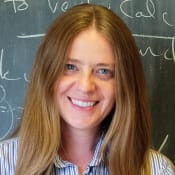
( - )
Areas of Specialization: Alegbraic, Geometric, and Topological Combinatorics, Chip-Firing
Caroline Klivans currently holds the title of Associate Professor of Applied Mathematics in the Division of Applied Mathematics at Brown University; she is also the Associate Director of the Institute for Computational and Experimental Research in Mathematics (ICERM). Klivans previously held positions at The University of Chicago and Cornell University. She earned her BA in mathematics at Cornell University in 1999, and PhD from MIT in 2003.
Klivans is mostly focused on algebraic, geometric, and topological combinatorics, particularly in regards to chip-firing games and sandpile models. Not to be seen as trivial, chip-firing games are an important method in developing and understanding the properties of finite structures, which has implications for fields beyond mathematics. Toward this, Klivans is seen as a leading authority on the subject, having authored The Mathematics of Chip-Firing.
For her work, Klivans has received awards and honors including a National Science Foundation Conference Grant, a VIGRE Postdoctoral Fellowship, a NSF Graduate Fellowship, the Brown University Brazil Initiative Grant, and the Alice T. Schafer AWM National Mathematics Prize.
11.Andrei Okounkov

(1969 - )
Moscow, Russia
Areas of Specialization: Representation Theory, Abstract Algebra, Infinite Symmetric Groups
Okounkov is Professor of Mathematics at Columbia University, where he works on representation theory and its applications. Representation theory is a branch of mathematics concerned with abstract algebraic structures and their representation. It has applications to a number of disciplines, including geometry, physics, and probability theory.
Okounkov received his education at Moscow State University in Russia, where he was awarded the Ph.D. in 1995. Formerly, Okounkov was a professor of mathematics at Princeton University, and before that he taught mathematics at the University of California, Los Angeles.
Okounkov is widely regarded as one of the world’s experts on issues in abstract algebra, particularly an area known as infinite symmetric groups, where Okounkov and colleagues have published original and substantive results (for mathematicians: the Gromov-Witten and other invariants of threefolds in algebraic geometry). Okounkov won the coveted Fields Medal, the highest honor in mathematics, in 2006. He became a Fellow of the American Academy of Arts and Sciences in 2016.
12.Fedor Bogomolov

(1946 - )
Moscow, Russia
Areas of Specialization: Algebraic Geometry, Number Theory, Hyperkähler Manifold, Bogomolov-Tian-Todorov Theorem
Fedor Bogomolov currently holds the title of Silver Professor of Mathematics at the New York University Courant Institute of Mathematical Sciences. Born in Moscow, Russia, Bogomolov completed his undergraduate studies at Moscow State University in 1970, and his PhD in mathematics in 1974 at the Steklov Institute of Mathematics. Prior to coming to NYU Courant in 1994 (after the fall of the USSR), Bogomolov held a professorial role at the Steklov Institute.
Bogomolov is a leading name in algebraic geometry in the last fifty years, attached to methods and theories including Bogomolov stability, Bogomolov-Miyaoka-Yau inequality, Beauville-Bogomolov form, and the Bogomolov conjecture. His discoveries and theories continue to receive wide-ranging applications in mathematics and beyond. He is also widely published, with more than 110 paper credits.
13.Mikhail Leonidovich Gromov
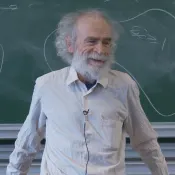
(1943 - )
Boksitogorsk, Russia
Areas of Specialization: Geometry, Analysis, Group Theory
Mikhail Leonidovich Gromov currently holds the title of Jay Gould Professor of Mathematics at the New York University Courant Institute of Mathematical Sciences, and is a member of the Institute of Advanced Scientific Studies (IHÉS). Prior to his current position, Gromov taught at , the University of Paris VI, and the University of Maryland, College Park. Born in Boksitogorsk, Russia, Gromov completed his master’s in mathematics at Saint Petersburg State University (formerly Leningrad State University) in 1965, and his PhD in 1969.
Gromov has been influential in the areas of geometry and analysis. In particular, Gromov is known as the originator of geometric group theory, which studies the relationship between geometric and algebraic properties. From his work, numerous models, conjectures, and theories have emerged that are tied to his name, including Gromov’s compactness theorem, the Gromov-Hausdorff convergence, Gromov’s Betti number theorem, the Bishop-Gromov inequality in Riemannian geometry, and Gromov-Witten invariants.
Notable works from Gromov include Metric Structures for Riemannian and Non-Riemannian Spaces.
For his work, Gromov has received awards and honors such as the Prize of the Mathematical Society of Moscow, the Oswald Veblen Prize in Geometry, the Wolf Prize in Mathematics, and the Abel Prize.
14.Jordan Ellenberg

(1971 - )
Potomac, Maryland, USA
Areas of Specialization: Arithmetic Geometry, Asymptotic Enumeration, Galois Representations
Jordan Ellenberg currently holds the title of John D. MacArthur Professor at the University of Wisconsin–Madison. He previously taught at Princeton University, and was a Postdoctoral Fellow at the Mathematical Sciences Research Institute (MSRI). Ellenberg completed his BA in mathematics at Harvard University in 1993, and his PhD in mathematics at Harvard in 1998.
Ellenberg’s work focuses on arithmetic algebraic geometry. Though he has a long list of research publications, lecture invitations, and seminars to his name, Ellenberg is perhaps best known as the author of the best selling book How Not to Be Wrong: The Power of Mathematical Thinking, bringing mathematical logic and thinking to a mainstream reading public. Additionally, Ellenberg has written a novel, The Grasshopper King.
For his work, Ellenberg has received awards and honors including a Guggenheim Fellowship, a Simons Fellowship in Mathematics, the William R. Kellett Award, and numerous grants.
15.Ken Ono

(1968 - )
Philadelphia, Pennsylvania, USA
Areas of Specialization: Number Theory, Integer Partitions, Modular Forms, Umbral Moonshine
Ken Ono currently holds the title of Thomas Jefferson Professor of Mathematics at the University of Virginia, and is also Vice President of the American Mathematical Society and Chair of the Mathematics Section in the American Association for the Advancement of Science. Previously, Ono held positions at University of Wisconsin–Madison and Emory University. Ono completed his BA at the University of Chicago in 1989, and his PhD at the University of California, Los Angeles in 1993.
Ono specializes in number theory, and is widely published, with over 160 article credits to his name. In particular, Ono is known for his expertise in integer partitions, which he has applied toward unraveling the work of famed mathematical phenom Srinivasa Ramanujan. Notably, Ono found a framework in 2014 that solves questions arising from the Rogers-Ramanujan identities. He also solved the Umbral moonshine conjecture, another Ramanujan puzzle. From this association, Ono is also considered an expert on Ramanujan, and was associate producer and mathematical consultant for the biographical movie on Ramanujan, The Man Who Knew Infinity.
Notable works from Ono include My Search for Ramanujan: How I Learned to Count.
For his work, Ono has received a variety of awards and honors, including the Prose Award for Best Scholarly Book in Mathematics, the Albert E. Levy Award for Scientific Research, a Guggenheim Fellowship, and the Presidential Early Career Award.
16.Charles Fefferman

(1949 - )
Washington, DC, USA
Areas of Specialization: Analysis, Partial Differential Equations
Not alone in this list of top mathematicians, Fefferman was a child prodigy. He received degrees in mathematics and physics at the University of Maryland, College Park at age 17. He received his Ph.D. in Mathematics at Princeton University in three years and by 22 he was full professor at the University of Chicago, the youngest full professor ever in the United States. At the ripe old age of 24, he returned to Princeton as full professor and has been there since. In 1984 he became Herbert Jones Professor of Mathematics at Princeton. Not surprisingly, the prodigy Fefferman won the Fields Medal in 1978.
Fefferman’s work in mathematics is focused primarily on partial differential equations, having unknowns that require modeling. Partial differential equations often have useful applications in computer models of complex systems, like weather forecasting and climate change. In addition to his career working out important results in partial differential equations, Fefferman has been extraordinarily prolific in diverse topics in the study of mathematics, from the mathematics involved in financial prediction, to fluid dynamics in, say, turbulent systems (i.e., chaos theory) to the study of neural networks in computer science (neural networks are an important topic in machine learning).
In addition to the Fields Medal, Fefferman won the Wolf Prize in Mathematics in 2017, and is a fellow of the National Academy of Science as well as the American Academy of Arts and Sciences.
17.Manjul Bhargava

(1974 - )
Hamilton, Ontario, Canada
Areas of Specialization: Bhargava Cube, Bhargava Factorial, 15 and 290 theorems
Bhargava is the R. Brandon Fradd Professor of Mathematics at Princeton University. He also holds a professorship at Leiden University in the Netherlands and multiple faculty positions at universities in his home country of India. Bhargava’s specialty in mathematics is number theory, the core and historically “famous” study of the integers. Bhargava was born in Canada and raised in Long Island. His mother Mira Bhargava is a mathematician at Hofstra University, who he calls his first math teacher. He received his bachelor’s degree in Mathematics from Harvard University in 1996, and his Ph.D. from Princeton in 2001.
Bhargava’s Ph.D. was itself an important result in the world of mathematics, a generalization of the 19th century mathematician Gauss’s law of composition for binary quadratic forms. Among many other accomplishments in number theory as well as fields in arithmetic, algebra, and representation theory, Bhargava has discovered 14 new Gauss-style composition laws in number theory.
Bhargava won the Fields Medal in 2014. He became a Fellow of the Royal Society in 2019. Popular Science named him one of the “Brilliant 10” in 2002.
18.Maxim Kontsevich
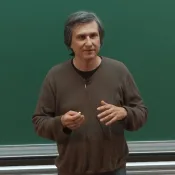
(1964 - )
Khimki, Russia
Areas of Specialization: Mathematical Physics, Noncommutative Algebra, Algebraic Geometry
Kontsevich is Professor of Mathematics at the prestigious Institut des Hautes Études Scientifiques in France, as well as a distinguished University of Miami. Having dual Russian and French citizenship, Kontsevich studied at Moscow State University. Having dual Russian and French citizenship, Kontsevich studied at Moscow University before leaving before degree completion to take a position as a researcher at the Institute for Information Transmission Problems in Moscow. His research there attracted the attention of the University of Bonn, where he was invited to attend. While there he sketched a proof of the famous Witten Conjecture, and was recognized as a true mathematical genius. He received his Ph.D. in Mathematics from the University of Bonn in 1992.
Kontsevich’s work focuses on difficult problems in the geometry of mathematical physics, such as knot theory (literally: the study of mathematical knots), as well as quantization and mirror symmetry. One of the best mathematicians of his generation, Kontsevich won the Fields Medal in 1998. He was awarded the Breakthrough Prize in Mathematics in 2014.
19.Carola-Bibiane Schönlieb
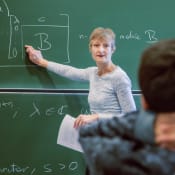
(1979 - )
Vienna, Austria
Areas of Specialization: Image Processing, Partial Differential Equations
Carola-Bibiane Schönlieb currently holds the title of Professor in Applied and Computational Analysis in the Department of Applied Mathematics and Theoretical Physics at the University of Cambridge. She is also a Turing Fellow of the Alan Turing Institute, Director of the EPSRC Centre for Mathematical and Statistical Analysis of Multimodal Clinical Imaging, and Director of the Cantab Capital Institute for the Mathematics of Information. Schönlieb is Austrian, and completed her MA in mathematics at the University of Salzburg in 2004. She earned her PhD in 2009 at Cambridge, and completed postdoctoral studies at the University of Göttingen.
Schönlieb ’s work is primarily focused in image processing and partial differential equations. In particular, Schönlieb has made significant progress in applying partial differential equations in image analysis and inverse imaging problems, and problems in 3D and 4D imaging. As an interdisciplinarian, Schönlieb’s work has significant implications for a wide range of fields that employ video imaging, including chemical engineering, biomedical sciences, and art.
In addition to her research, Schönlieb is active in encouraging and advocating for women in mathematics, and is active with the European Women in Mathematics Association, and the Committee for Women in Mathematics.
For her work, Schönlieb has received awards and honors including the Whitehead Prize of the London Mathematical Society, the Philip Leverhulme Prize, and was named the Mary Cartwright Lecturer of the London Mathematical Society.
20.Roger Penrose

(1931 - )
Colchester, England
Areas of Specialization: Mathematical Physics, General Relativity, Cosmology
Penrose is Emeritus Rouse Ball Professor of Mathematics at the University of Oxford. He is also Emeritus Fellow of Wadham College, a constituent college of Oxford, and an honorary Fellow of Saint John’s College, Cambridge. Penrose received his bachelor’s in mathematics (first-class degree) from University College, London, and completed his Ph.D. at St. John’s College, Cambridge in 1958.
Along with the late Stephen Hawking, Penrose is one of a select few mathematicians (or mathematical physicists, in the case of Hawking) who are generally known and “famous.” Over his impressive career, Penrose has developed sophisticated mathematics to analyze Einstein’s “space-time,” contributing greatly to our understanding of fundamental physics. His exploration of mathematical singularities has expanded our understanding of core phenomena like the Big Bang and Black Holes. Penrose used advanced mathematics to develop a theory of how energy can be extracted from a Black Hole, now called the “Penrose process” in his honor. He is also known for his contributions to tiling theory, another area of mathematics dealing with shapes and topologies. He discovered the eponymous Penrose tilings in 1974. He is also known for Penrose Diagrams, causal diagrams connecting points in spacetime.
In addition to his ongoing and fundamental contribution to mathematics and mathematical physics, Penrose is a successful popularizer of difficult concepts in the sciences. His The Road to Reality: A Complete Guide to the Laws of the Universe, published in 2004 is a readable tour of the laws of physics for interested non-specialists. He is also known for his foray into the problem of consciousness (what is the nature of conscious experience?), writing two widely-read books on the subject, where he argues that consciousness arises from quantum events in the brain.
Penrose was elected a Fellow of the Royal Society in 1972. Among his many other accomplishments, he won the prestigious Eddington Medal with Stephen Hawking in 1975, and the Albert Einstein Medal in 1990. In 1994, Penrose was knighted for his outstanding service to science and mathematics.
21.Edward Witten

(1951 - )
Baltimore, Maryland, USA
Areas of Specialization: String Theory, Quantum Gravity, Supersymmetric Quantum Field Theory
Witten is Professor of Mathematical Physics at Princeton’s Institute for Advanced Study (IAS). He is known world-wide for his many important contributions to the mathematics of string theory and treatments of theoretical physics. Interestingly, Witten received his Bachelor of Arts degree in History, with a minor in Linguistics at Brandeis University in 1971. After graduation, Witten wrote for The New Republic and The Nation, and even worked on George McGovern’s presidential campaign! He returned to college and studied economics at the University of Wisconsin–Madison before dropping out, returning to Princeton University to study applied mathematics, where he received his Ph.D. in Physics in 1976.
The rest, as they say, is history. Witten won the “genius award,” the MacArthur Grant in 1982, and had won the Fields Medal in Mathematics in 1990. Technically a physicist (not a mathematician), the noted mathematician Michael Atiyah noted that Witten’s “command of mathematics is rivaled by few mathematicians, and his ability to interpret physical ideas in mathematical form is quite unique.” Indeed, with Witten’s talent it is difficult to separate his thinking about theoretical physics with mathematics proper, as the “thinking” about physics is done in the language of mathematics. At any rate, Witten is widely regarded as one of the finest mathematicians in the world, as the Fields Medal surely attests.
Among many other awards, Witten received the Nemmers Prize in Mathematics in 2000.
22.James Maynard

(1987 - )
Chelmsford, England
Areas of Specialization: Prime Gaps, Duffin-Schaeffer Conjecture
James Maynard is a research professor at the University of Oxford, and was previously a postdoctoral researcher at the Université de Montréal. He completed his bachelor’s and master’s degrees at University of Cambridge in 2009, and earned his Ph.D. at Oxford in 2013.
One of the youngest names among influential mathematicians, Maynard was just 26 when he came to prominence after providing a different proof to a popular theory of prime gaps at the time provided by Yitang Zhang. Indeed, Maynard is seen as a kind of specialist in prime gaps, and also solved a conjecture proposed by Paul Erdős concerning the topic. More recently, he helped prove the Duffin-Schaeffer conjecture.
For his work, Maynard has received several major awards, including the SASTRA Ramanujan Prize, the Whitehead Prize, the EMS Prize, and the Cole Prize in Number Theory.
Academic Website23.Peter Lax
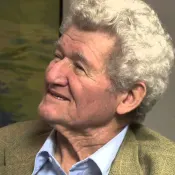
(1926 - )
Budapest, Hungary
Areas of Specialization: Lax-Wendroff Method, Lax Equivalence Theorem, Babuška-Lax-Milgram Theorem, Lax Pairs
Hungarian-born Peter Lax currently holds the title of Professor Emeritus at the Courant Institute of Mathematical Sciences at New York University. Lax began working at NYU in 1951; prior to that, he worked on the Manhattan Project.
Lax’s family emigrated from Hungary in 1941 while he was a teenager, and at 17 he was able to study for three semesters at NYU (where he wound up acting as an instructor). He was drafted into the U.S. army and allowed to take classes at Texas A&M University, though his studies were again interrupted when he was sent to work at the Oak Ridge National Laboratory, as well as the Manhattan Project (all before earning an undergraduate degree). He was finally able to return to NYU in 1946, earn his bachelor’s degree with pooled credits, and complete his PhD there in 1949.
As a mathematician, Lax is known for a wide body of work on partial differential equations, pure mathematics, fluid dynamics, shockwaves, and computing. In particular, Lax is famous for the “Lax conjecture” about hyperbolic polynomials, which he proposed in 1958, and which went unproven for over four decades.
Published works from Lax include Linear Algebra and Its Applications.
For his work, Lax has received numerous awards and honors, including membership with the Norwegian Academy of Science and Letters and the (American) National Academy of Sciences, as well as a Lester R. Ford Award, National Medal of Science, Wolf Prize, Abel Prize, and fellowship with the American Mathematical Society.
24.Barry Mazur

(1937 - )
New York City, New York, USA
Areas of Specialization: Diophantine Geometry, Generalized Schoenflies Conjecture, Mazur Swindle, Mazur’s Torsion Theorem
Barry Mazur currently holds the title of Gerhard Gade University Professor at Harvard University, where he has worked as a professor since 1962. Prior to his long tenure at Harvard, Mazur held post-doctoral fellowships at Harvard and the Institute for Advanced Study. Mazur earned his PhD in Mathematics at Princeton University; though he attended Massachusetts Institute of Technology as an undergraduate, he did not complete a bachelor’s degree.
Mazur boasts a long career of discoveries and advancements in geometry, arithmetic, and number theory. In fact, he has several discoveries and proofs named after him, including the Mazur swindle, the Mazur manifold, and Mazur’s torsion theorem. Mazur is particularly famous for the latter, which was used by Andrew Wiles in his groundbreaking proof of Fermat’s Last Theorem.
Notable works from Mazur include Imagining Numbers and Prime Numbers and the Riemann Hypothesis.
For his work, Mazur has received awards and honors including membership with the American Philosophical Society, the Steele Prize, the Cole Prize, and the Veblen prize from the American Mathematical Society, as well as fellowship, and the Chauvenet Prize from the Mathematical Association of America.
25.Alain Connes

(1947 - )
Draguignan, France
Areas of Specialization: Baum-Connes Conjecture, Noncommutative Geometry, Operator Algebras, Thermal Time Hypothesis
Connes is currently Professor at the Collège de France, IHÉS, in France, as well as at Ohio State University and Vanderbilt University. Connes’ work focuses on algebra, or what is known as “operator algebra,” an important area in functional analysis. Born in France, Connes received his undergraduate degree in Mathematics from the prestigious École normale supérieure in Paris and his Ph.D. from the University Pierre et Marie Curie.
Among other notables, Connes was a member of Bourbaki, a group of predominantly French mathematicians who formed after the First World War in response to the loss of so many mathematicians in the wake of the war. The Bourbaki group (a pseudonym-there was no person “Bourbaki”) consisted of world-class mathematicians who contributed to mathematics by taking up the task of writing major new texts. Connes is also known for fundamental work in mathematics, such as the Connes embedding problem, a problem in algebra. He is also known for the Baum-Connes conjecture and has made important contributions to differential geometry.
Connes was awarded the Fields Medal in 1982. He is a member of the French Academy of Sciences as well as the US National Academy of Sciences (and others, including Danish, Norwegian, and Russian).
Honorable Mentions in Mathematics
- George Andrews, Pennsylvania State University
- John Horton Conway, Princeton University
- Simon Donaldson, Imperial College London
- Ronald Graham, University of California, San Diego
- Larry Guth, Massachusetts Institute of Technology
- János Kollár, Princeton University
- Marcus du Sautoy, University of Oxford
- Peter Scholze, University of Bonn
- Shing Tung Yau, Harvard University
- Isadore Singer, Massachusetts Institute of Technology
- Zhiwei Yun, Massachusetts Institute of Technology